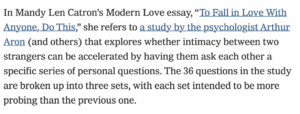For my Critical Play assignment, I engaged with “36 Questions: How to Fall in Love,” a game that transforms psychologist Arthur Aron’s intimacy-building questions into a digital experience. The game is hosted on a website, and its target audience is 15 and older, with a focus on adults given the website’s suggestion to deepen their connection over wine and due to the mature theme of vulnerability many of the questions evoke.

“36 Questions” uses a straightforward set of formal elements: a sequence of increasingly personal questions presented on a digital platform. This simplicity in structure directs player interaction and emotional engagement, aiming to create an aesthetic of intimacy and vulnerability. The game’s design—progressive questioning within a relaxed setting—facilitates open, intimate exchanges, crucial for the experience it seeks to create.
Initially, I intended to play “36 Questions” with a stranger, possibly by approaching someone at a local hangout like Tressider or CoHo. However, the depth of engagement required, exemplified by prompts such as “Stare into your partner’s eyes for four minutes,” made me reconsider. It became clear that the game targets those seeking deep connection, intimacy, and potentially, love, and I didn’t feel ready to play the game with someone I didn’t know.
Instead, I chose to play with a close friend to test whether the game could strengthen our existing bond. The lack of formal instructions led us to treat it as a turn-based conversation, where we alternated answering each question. I noticed the dynamic nature of our interaction: the depth of my responses was influenced by my partner’s openness and detailed answers. This, albeit somewhat forced, led to personal revelations and a deeper understanding of our similarities. The game experience, while profound, sometimes felt monotonous and drawn-out, especially since I was already familiar with my partner’s personality. This led me to ponder the game’s appeal to those in deeply intimate relationships. Could it maintain its fun and relevance for those who already know each other well?
This experience was insightful when I met with my game design team to discuss our game “In the Loop.” Similar to “36 Questions,” “In the Loop” is designed to foster social connections among its participants. It is a card-based “getting-to-know-you” game that utilizes a variety of prompts to engage players. However, there are notable differences that distinguish it from “36 Questions.” Unlike the fixed sequence of questions in “36 Questions,” “In the Loop” features a flexible card-based mechanism. In our game, one player picks a card with a prompt and shares their response, then another player selects a different card and shares theirs. This approach not only speeds up the gameplay but also reduces the potential for stagnancy—a challenge I noted while playing “36 Questions.”
Additionally, we’ve introduced a wild card—a blank card that a player can draw and use to ask any question they choose. This element enhances player freedom and customization, further diversifying the game dynamics and maintaining player engagement by allowing for unexpected and personalized interactions. These modifications are designed to adapt and evolve the gameplay, ensuring a dynamic and engaging experience for all participants.
Furthermore, “In the Loop” features three distinct decks: Beginner, Medium, and Spicy. This tiered approach caters to different interaction depths, allowing players to choose their comfort level, which can vary from light-hearted fun to deep emotional engagement. By offering these options, our game accommodates a broader range of social interactions than “36 Questions,” which is more focused on fostering deep intimacy and vulnerability.
Lastly, “In the Loop” diverges from “36 Questions” by offering three distinct modes: Beginner, Medium, and Spicy. Each mode consists of a deck of 10 cards with questions and prompts that elicit varying levels of vulnerability. This design choice recognizes that players have different motivations for engaging with the game and varying comfort levels with intimacy. For example, some players might choose the game for lighthearted fun or silly interactions, while others might use it as a drinking game. Conversely, some might select it to deepen connections with close friends or partners, aiming to achieve greater levels of intimacy.
Ultimately, while “36 Questions” focuses on fostering deep intimacy and vulnerability, “In the Loop” is crafted to support a wider range of social interactions, allowing players to tailor the experience to their specific social goals.


